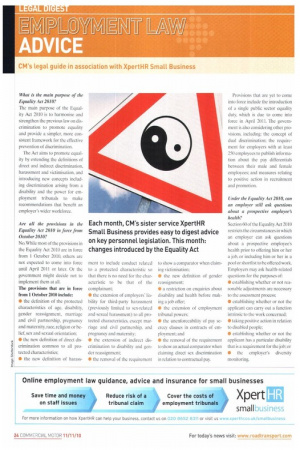Each month, CM's sister service XpertHR Small Business provides easy
Page 24

If you've noticed an error in this article please click here to report it so we can fix it.
to digest advice on key personnel legislation. This month: changes introduced by the Equality Act
What is the main purpose of the Equality Act 2010?
The main purpose of the Equality Act 2010 is to harmonise and strengthen the previous law on discrimination to promote equality and provide a simpler, more consistent framework for the effective prevention of discrimination.
The Act aims to promote equality by extending the definitions of direct and indirect discrimination, harassment and victimisation, and introducing new concepts including discrimination arising from a disability and the power for employment tribunals to make recommendations that benefit an employer's wider workforce.
Are all the provisions in the Equality Act 2010 in force from October 2010?
No. While most of the provisions in the Equality Act 2010 are in force from 1 October 2010. others are not expected to come into force until April 2011 or later. Or the government might decide not to implement them at all.
The provisions that are in force from 1 October 2010 include: • the definition of the protected characteristics of age, disability, gender reassignment, marriage and civil partnership, pregnancy and maternity, race, religion or belief, sex and sexual orientation; • the new definition of direct discrimination common to all protected characteristics; • the new definition of harass ment to include conduct related to a protected characteristic so that there is no need for the characteristic to be that of the complainant; • the extension of employers' liability for third-party harassment (previously limited to sex-related and sexual harassment) to all protected characteristics, except marriage and civil partnership, and pregnancy and maternity; • the extension of indirect discrimination to disability and gender reassignment; • the removal of the requirement to show a comparator when claiming victimisation; • the new definition of gender reassignment; • a restriction on enquiries about disability and health before making a job offer; • the extension of employment tribunal powers; • the unenforceability of pay secrecy clauses in contracts of employment; and • the removal of the requirement to show an actual comparator when claiming direct sex discrimination in relation to contractual pay. Provisions that are yet to come into force include the introduction of a single public sector equality duty, which is due to come into force in April 2011. The government is also considering other provisions, including: the concept of dual discrimination; the requirement for employers with at least 250 employees to publish information about the pay differentials between their male and female employees; and measures relating to positive action in recruitment and promotion.
Under the Equality Act 2010, can an employer still ask questions about a prospective employee's health?
Section 60 of the Equality Act 2010 restricts the circumstances in which an employer can ask questions about a prospective employee's health prior to offering him or her a job, or including him or her in a pool or shortlist to be offered work. Employers may ask health-related questions for the purposes of: • establishing whether or not reasonable adjustments are necessary to the assessment process; • establishing whether or not the applicant can carry out a function intrinsic to the work concerned; • taking positive action in relation to disabled people: • establishing whether or not the applicant has a particular disability that is a requirement for the job; or
• the employer's diversity monitoring.




























































































































